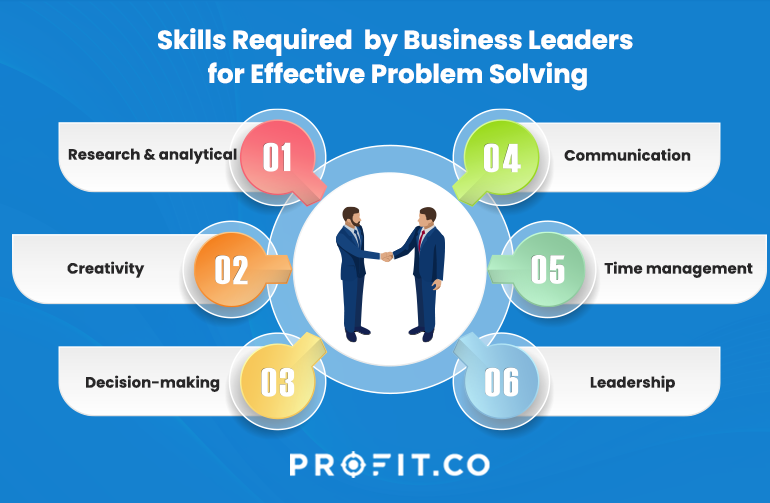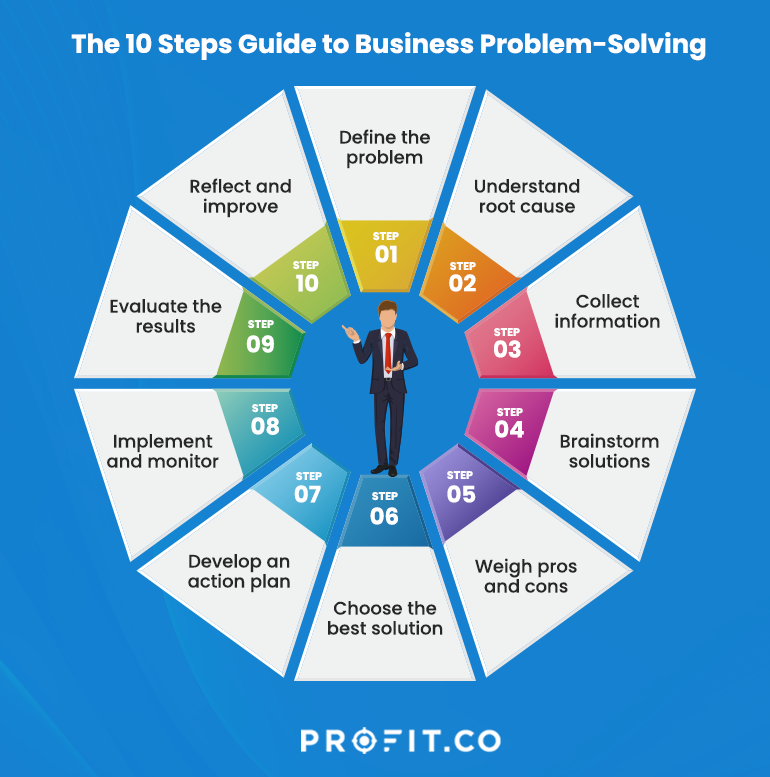Companies today are expected to adapt and respond quickly to challenges in a rapidly changing business environment. Notwithstanding sound planning and flawless strategy execution, businesses can still face problems. While they foresee some of those problems, others can pop up unexpectedly. These unforeseeable problems make it essential for businesses to be agile enough to respond to those challenges quickly and have excellent problem-solving skills to navigate them successfully. Problem-solving is an indispensable part of business management.
In this article, we will examine the following in detail
Content
- Introduction
- Understanding the Importance of Problem-Solving in Business
- Types of Business Problems
- Challenges in Problem-solving
- Skills Required for Effective Problem-solving in Business
- A Step-by-step Process to Problem-solving in Business
- FAQs
TL;DR Version
Problem-solving is integral to business success, dealing with diverse issues ranging from operational hiccups to strategic challenges. Identifying and understanding these problems is vital, but navigating potential obstacles during problem-solving, such as cognitive biases, resource constraints, and lack of information, is crucial.
Effective problem-solving skills include research and analytical abilities, creativity, decision-making, communication, time management, and leadership. These skills allow business leaders to dissect complex issues, ideate innovative solutions, make informed decisions, communicate effectively, manage time, and lead teams toward resolution.
The problem-solving process involves defining the problem, understanding its root cause, collecting relevant information, brainstorming potential solutions, evaluating these solutions, choosing the best one, developing and implementing an action plan, monitoring progress, evaluating results, and reflecting on the process for continuous improvement. This iterative process ensures that businesses are resolving immediate issues and refining their problem-solving mechanism for future challenges.
Introduction
Unmanaged and unmitigated problems can cause severe consequences to businesses. They can lead to project delays, missed deadlines, and financial losses. Moreover, they may negatively impact employee morale and customer satisfaction and even damage the reputation of the company. So businesses must have strong problem-solving abilities.
When businesses have strong problem-solving abilities, they can quickly and proactively rise to the occasion and address the problems, minimizing their impact, preventing them from escalating into bigger problems, and capitalizing on opportunities that arise from those challenges. Ultimately, the problem-solving ability of a company can help them gain a competitive advantage.
To solve problems and fix issues, companies require leaders who can handle complex issues with ease and guide and motivate their teams to identify problems and develop creative solutions to overcome them. They can leverage the collective expertise and experience of the employees to make well-informed decisions that align with the business goals and objectives. Leaders also work with employees to foster a culture of problem-solving to help the company build a resilient business that can thrive in today’s dynamic business environment.
What is Problem-Solving in Business?
Problem-solving involves identifying, analyzing, and resolving issues or challenges arising during various business operations to achieve the desired outcomes and business goals. It involves a systematic approach to defining the problem, gathering relevant information, generating possible solutions, evaluating them, and implementing the best course of action.
Take action today and start paving the way for your business towards Problem- solving.
we Cannot solve our problems with the same thinking we used when we created them.
Why is Problem-Solving Important?
Problem-solving in business is important because of the following reasons.
1. Efficiency
Problems not only hinder progress but also reduce the efficiency of your operations by bringing everything to a halt/slowing you down, causing downtime, and costing you precious productivity. When left unchecked at the initial stages, these problems may also demand additional resources and budget to solve them, leading to cost overruns, losses, and inefficiency. So addressing the problems on time can help achieve efficiency.
2. Profitability
Profitability is one of the topmost priorities of an organization. So any impact on profitability is seen as a problem that requires immediate attention. Effective problem-solving helps businesses identify and address cost inefficiencies, optimize processes, and capitalize on new opportunities, thus improving the bottom line.
3. Leadership
Great leaders emerge during testing times. They can lead the employees, leverage collective effort and give a sense of direction toward finding solutions and workarounds. Problem-solving helps companies identify the right leaders.
4. Teamwork
Problem-solving requires team effort and participation. It calls for collaboration and communication between various departments, teams, and individuals. When companies manage to weather challenges and solve problems effectively, it brings the employees together to work towards a common cause, build stronger teams and create a habit of continuous improvement.
5. Innovation
Problem-solving requires creativity and innovation to find solutions and workarounds. When a company fosters problem-solving culture, it automatically imbibes creative thinking and innovation. It gets reflected in developing new products, services, processes, and best practices.
6. Customer Satisfaction
Customer satisfaction helps businesses retain and find new customers. Problems with the products/services and customer support can lead to poor customer experience. Effective problem-solving helps businesses resolve customer complaints and issues quickly and satisfactorily, thus increasing customer loyalty and retention.
The Problems that Businesses Face Today and how they Solve Them
There are several different kinds of problems that businesses face, including
1. Strategic problems
Strategic problems are related to the long-term direction of a business. They typically involve decisions about resource allocation, product strategy, choosing the market, pricing strategy, product positioning, etc. Solving strategic problems requires a long-term vision, able leadership, and the ability to forecast market trends.
Business problem examples
Selecting the markets
Businesses need to decide their focus on specific geographic markets, target customer segments, and product categories. They must make these decisions and select the focus areas by analyzing the data and insights into factors, including market size, competition, and the company’s core competencies.
Product development
Developing new products enables companies to remain relevant and achieve leadership in a highly competitive market scenario. They have to meet the customer requirements and provide a compelling reason for customers to purchase them. Solving the problem of new product development requires creativity and innovation and allocating resources for R&D. New products should be developed based on sound market analyses of customer requirements and pain points.
For instance, the need to learn and upskill anytime without compromising work hours pushed the companies to create e-learning platforms.
Positioning the company
Differentiating your business from the competition involves developing a strong brand identity, focusing on a specific niche or segment of the market, or offering unique value propositions. Setting the company apart by gaining a competitive advantage attracts customers. You can solve the problem of positioning your company by doing a SWOT analysis, finding your strengths and unique qualities that enable you to meet the customers’ requirements and address their pain points. You can base your brand identity, USP, and niche on your stand-out qualities that benefit customers. For instance, Volvo positions itself as the company that makes the safest cars in the world.
2. Operational problems
Operational problems are daily issues that hinder companies from efficiently delivering products or services to customers, affecting their ability to meet deadlines and targets. These problems arise from bottlenecks, inefficiencies, and system flaws. Addressing them involves identifying issues, providing employee training, upgrading technology, ensuring product testing and quality control, and implementing contingency planning, deadline management, and risk mitigation.
Business problem-solving examples
Supply chain disruptions
Supply chain disruptions happen when businesses face challenges in sourcing raw materials or components, leading to production delays or quality issues. For instance, during the pandemic, companies faced chip shortages, which led to losses and the inability to deliver products to customers on time. It also caused a rise in demand and an increase in prices.
Quality control issues
Quality control issues occur when design flaws or manufacturing issues impact the products. Businesses may need to identify and address quality issues to maintain customer satisfaction and loyalty. For instance, it is not uncommon to recall new automobile models, sometimes the ones from specific batches, to replace faulty components with redesigned parts before they might fail.
Managing staffing levels
Fluctuating staffing needs are part of operational issues. At any given time, if a company is understaffed, it can lead to operational inefficiency; if it is over-staffed, the company will suffer from cost infficiency. So, it requires careful planning. You can address the problem by either recruiting or downsizing and restructuring. For instance, the tech companies that designed software solutions for remote and hybrid work environments hired many employees during the pandemic. After the pandemic, when the need for these software solutions decreased, they had to downsize their workforce in light of the impending recession.
3. Financial problems
Financial problems are issues involving managing cash flow, revenue growth, and expenses. They are related to the financial health of a business. Businesses can fix them by managing costs effectively through process improvement and cost-cutting measures.
Business problem-solving examples
Managing cash flow
Businesses must ensure that they have enough financial resources on hand to meet their obligations, such as payroll, vendor payments, logistics, managing retail channels, etc. For instance, many start-ups stall despite successful product development and prototyping, as they fail to secure adequate funding to bring the products to the market.
Identifying new revenue streams:
Businesses that focus on a particular niche are always vulnerable to competition and changing market conditions. They need to diversify their revenue streams to maintain growth and profitability. They may have to focus on research and product development to identify new revenue streams. For instance, some of the most successful and established DSLR camera manufacturers faced a major crisis when mirrorless cameras started eating into their market share. They had to revise the product strategy, downsize their manpower, and invest vast resources into developing competitive mirrorless systems to mitigate the company. On the contrary, DSLR manufacturers with diversified businesses remained more resilient.
Managing costs
Businesses must control expenses to maintain profitability. It may involve identifying areas where costs can be cut or negotiating better deals with vendors. For instance, Google is known to initiate moonshot projects. At the same time, they kill non-profitable projects quickly. It has helped the company retain leadership while managing costs judiciously.
4. Human resource problems
HR problems are issues related to recruiting, retaining, and developing talent. They are issues about the management of employees. Managing these problems requires assessing staffing needs, recruiting, restructuring, identifying training and upskilling needs, and retaining top talent through employee engagement initiatives, welfare measures, and career development opportunities.
Business problem-solving examples
Retaining top talent
Retaining top talent can be a determining factor for the success of a company. Businesses must build an environment that attracts top talent by creating opportunities for career advancement and offering competitive compensation packages. For instance, highly specialized jobs with business-critical responsibilities, such as chief aero designers in motor racing teams, are hard to find and recruit. So retaining them is crucial for the success of the company.
Addressing employee morale and motivation issues
Lack of motivation, stagnant career, unfavorable team dynamics, etc., are some factors that cause a dip in employee morale. These factors can affect productivity and quality of work. Businesses must address these issues through employee engagement initiatives, career planning, team building, welfare measures, training, upskilling, etc.
Managing a diverse workforce
In an increasingly globalized work scenario, businesses must ensure that they create a work environment that is inclusive and welcoming to employees from different backgrounds and with diverse skill sets. They should also manage hybrid and remote work to address ambiguities and ensure clarity and synergy among teams and individuals based in various locations. For instance, many companies reserve certain positions for people of different racial/ethnic backgrounds or genders to meet their diversity goals. They also put policies and systems in place to prevent/address discrimination in the workplace.
Marketing problems
Marketing problems are related to promoting and selling a company’s products or services. Problems usually arise in understanding customer behavior and preferences and developing marketing strategies that appeal to those customers. Solving marketing problems requires revisiting the marketing strategy, understanding customer needs and behaviors by analyzing data, positioning the products more appealingly, and branding them better to reflect the strengths of the company and its product offerings.Business problem examples
Understanding customer needs and behavior
Customer needs to dictate the direction of product development and positioning. To design and deliver successful products, businesses must gain a deep understanding of customer needs, preferences, and pain points. For instance, the Japanese car makers capitalized on the high gas prices during the oil crisis and managed to capture the market in the US with their more efficient and reliable cars. The sudden loss in interest in the large, thirsty cars caused a considerable shift in the market, allowing Japanese car manufacturers to position their products in line with the customers’ preferences and succeed.Developing a strong brand identity
Businesses must create a brand identity that resonates with the customers and sets them apart from competitors. For instance, it is common for companies to change their logo and brand identity in line with the changing trends, customer preferences, and product strategy.Identifying new marketing channels and tactics
Businesses must be able to identify and adapt to changing customer preferences and identify new channels and tactics for reaching those customers. For instance, many retail businesses have adopted an eCommerce strategy to cater to mobile-savvy customers and to reach new markets.
What Skills do Business Leaders Require for Effective Problem-Solving?
Following are some of the skills required for effective problem-solving in business.1. Research and analytical skills
Problems have various potential implications. Trying to solve them straight away without doing proper research can cause further problems. Business leaders should study the problem to gain a deeper understanding, assess the solutions thoroughly, and test them before deploying them. They also need good analytical skills to review the performance metrics that indicate the problem areas and analyze information and data to understand the problem. Analytical skills help business leaders break down complex problems into smaller, more manageable parts, identify their root causes, avoid bounded rationality in decision making, and develop effective solutions and creative workarounds.2. Creativity
When the problems are complex and multi-dimensional, they may require unique solutions that never existed before. Finding solutions for these problems requires creativity and a culture of innovation in the company. Business leaders must think creatively and tread unconventional paths to create innovative solutions. For instance, during the pandemic, when customers did not want to take the risk of going to retail stores to buy things but were reluctant to pay for the high shipping costs involved in e-commerce, retail businesses offered solutions such as BOPIS that let customers order online and collect their purchases safely from collection booth/kiosk at a convenient time. It helped them meet customer needs by offering the best of both worlds3. Decision-making
Effective problem-solving in business requires sound decision-making skills. Problem-solving often involves making choices and tough decisions. For instance, the decision to axe a product line that has performed well in the past but has no future potential is a tough one to make. But retaining it will cost resources and yield decreasing returns. Great business leaders evaluate multiple options/solutions and make decisions in the company’s best interest. Being decisive or having decision clarity also means making the right decisions at the right time. Delays in decision-making can cause severe consequences even if you ultimately make the right decision. So business leaders must analyze everything and make the right decision when it matters the most.4. Communication
Business leaders cannot single-handedly solve problems. Problem-solving requires a team effort. Good business leaders harness the potential of every employee with their communication skills and excellent coordination. They communicate effectively with colleagues, customers, and stakeholders to identify problems and develop solutions. For instance, in a crowded restaurant, the chef needs to coordinate the kitchen staff continuously, check if they are doing their part efficiently, control food quality, and make sure that food is served at the right table as quickly as possible. Lack of communication from the chef can escalate into a full-fledged nightmare, where customers keep waiting for their orders, kitchen staff make mistakes and deliver poor quality food, and the waiters get the flak for not serving food on time. Such situations can ruin the reputation of the restaurant and lead to the loss of customer trust. So good business leaders must communicate and build synergy among the individuals within and among other teams to get work done effectively.5. Marketing problems
Marketing problems are related to promoting and selling a company’s products or services. Problems usually arise in understanding customer behavior and preferences and developing marketing strategies that appeal to those customers. Solving marketing problems requires revisiting the marketing strategy, understanding customer needs and behaviors by analyzing data, positioning the products more appealingly, and branding them better to reflect the strengths of the company and its product offerings.
6. Leadership
Problem-solving is about working with many individuals and bringing the best out of them. So business leaders need great leadership qualities to motivate and inspire their teams to work together and solve problems. For example, innovations come from the R&D department; they get incorporated into products by the product development team, and the products are positioned and promoted in the market by the marketing team. Great business leaders lead product development and deployment by coordinating with all these teams, getting their insights, considering their views, and making important decisions regarding product strategy, product positioning, and branding. Situational Leadership is essential to deal with shifting priorities. Leaders motivate the teams and guide them in the right direction. Without good leadership, a company cannot solve problems effectively.A Step-by-Step Process to Problem-Solving in Business
Problem-solving in business is often an iterative process. So the steps involved may need to be repeated or revised as new information becomes available. Problem-solving usually involves the following steps:- Define the problem; include any present symptoms or effects.
- Understand the root cause of the problem and find out how it impacts the business.
- Collect all the necessary information related to the problem by analyzing data, conducting interviews, researching, and seeking input from others.
- Brainstorm with the stakeholders and generate potential solutions to the problem. Encourage open communication, collaboration, and participation among team members.
- Weigh the pros and cons, evaluate all the potential solutions, analyze the risks, and consider the feasibility of each.
- Choose the best solution from the evaluated solutions and consider how it will impact the stakeholders, including customers, employees, suppliers, and shareholders.
- Develop an action plan to implement the chosen solution, detailing specific steps, timelines, and responsibilities.
- Implement the solution, monitor progress closely, adjust the plan, make changes as required, and communicate those changes to the stakeholders.
- Evaluate the results, determine if the solution addressed the problem, assess its effectiveness, and identify any areas for improvement.
- Reflect on the problem-solving process, and identify and document the lessons learned.
- Consider how you can improve the process for future problem-solving efforts.

Problem Solving Key Takeaways
Problem-solving is a critical skill for business success. It involves identifying, understanding, and resolving issues in various facets of business operations and strategy. Common obstacles during problem-solving can include cognitive biases, resource constraints, and lack of information. Business leaders must navigate these potential pitfalls to ensure effective resolution of issues. Essential skills for effective problem-solving include research and analytical abilities, creativity, decision-making, communication, time management, and leadership. These skills enable business leaders to dissect complex issues, devise innovative solutions, make informed decisions, effectively communicate, manage time, and guide teams toward resolution. Problem-solving is an iterative process that involves multiple stages, from defining the problem and understanding its root cause to brainstorming and evaluating potential solutions, choosing the best one, and developing and implementing an action plan. This process also includes monitoring progress, evaluating results, and reflecting on the process for continuous improvement. An effective problem-solving method is the root cause analysis method. Ultimately, successful problem-solving in business is not just about resolving immediate issues but also about refining and improving the problem-solving process to tackle future challenges more effectively.Problem Solving in Business FAQs
- What are the 4 types of problem-solving strategies?
Answer: The four types of problem-solving strategies typically include:
Trial and Error: Involves trying different solutions until the problem is solved. It’s often used when there are limited possibilities that can be explored quickly.
Algorithm: A step-by-step procedure that, if followed correctly, will always lead to the solution of the problem. It is highly logical and often used in mathematical problems.
Heuristic: A general problem-solving strategy that involves using rules-of-thumb or shortcuts. Heuristics may not always yield the perfect solution but can often lead to a satisfactory one in a reasonable time frame.
Insight: Sometimes also referred to as creative problem-solving. It involves sudden realization, a flash of inspiration, or an ‘Aha!’ moment that provides a solution.
- What is an example of problem-solving in business?
- Why is problem-solving important in business?
- What is the most important problem-solving tool for business?
Answer: A common example of problem-solving in business is addressing a sudden drop in sales. The problem-solving process would begin with identifying and defining the problem (drop in sales). The next step would involve researching and analyzing the issue to understand its root cause, such as market conditions, competition, or internal factors. Brainstorming for potential solutions could include improving the product, adjusting pricing, or enhancing marketing efforts. After evaluating and selecting the best solution, an action plan would be developed and implemented. Progress would be monitored, results evaluated, and the process reflected upon for future problem-solving efforts.
Answer: Problem-solving is vital in business as it enables organizations to navigate challenges and obstacles that could hamper their growth and success. It allows businesses to identify issues, understand their implications, and devise effective solutions. This process not only resolves the immediate issue at hand but also helps prevent similar problems in the future. Moreover, effective problem-solving can lead to improved business processes, innovation, and a competitive advantage. It also plays a crucial role in customer satisfaction, profitability, and overall sustainability of the business.
Answer: There isn’t a one-size-fits-all problem-solving tool for all businesses, as the most effective tool often depends on the specific problem and the business context. However, one universally important tool is effective communication. Clear, open, and honest communication fosters better understanding of problems, facilitates brainstorming of solutions, and aids in the implementation of action plans. Other essential tools include data analysis tools (for understanding and diagnosing problems), brainstorming techniques (for generating solutions), and project management tools (for implementing solutions).










